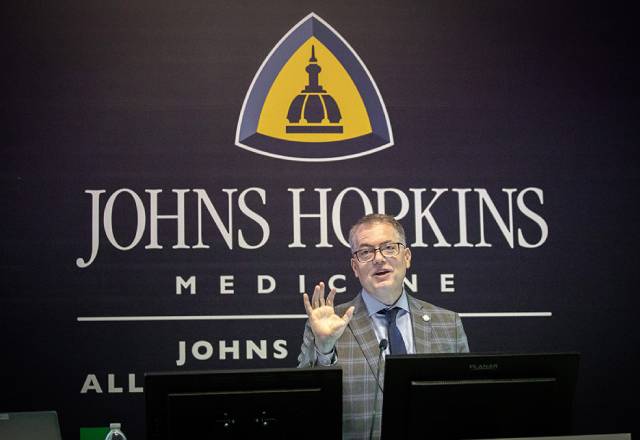Safety-II: A Proactive Approach to Positive Outcomes

James Frederick, Deputy Assistant Secretary of Labor for Occupational Safety and Health (OSHA)
James Frederick starts each day thinking about the 14 people who die in the workplace on the average day. He remembers working as a leader with the United Steelworkers Union and investigating such incidents. He recalls sitting across from families of those workers wrestling with how to answer questions about how their loved ones were lost.
Now Deputy Assistant Secretary of Labor for Occupational Safety and Health (OSHA), Frederick channels that motivation into seeking ways to improve safety for employees, patients and anyone in a workplace.
“It helps me to motivate and understand the things that OSHA needs to be focusing on in order to try to shift the dynamics now,” says Frederick, who spoke recently at the three-day Safety-II: Practical Applications Conference at Johns Hopkins All Children’s Hospital in St. Petersburg, Florida.
The conference brought together worldwide experts in a variety of industries to focus on “Safety-II,” a next-generation way of thinking about employee and patient safety. Speakers included Erik Hollnagel, Ph.D., senior professor of patient safety at Jönköping University in Sweden, who pioneered the Safety II philosophy, and Todd Conklin, a senior adviser at Los Alamos Laboratories. The audience included employee and patient safety professionals from companies such as Netflix, Children’s Hospitals’ Solutions for Patient Safety, Tesla, Chrysler, and Siemens in addition to a large contingent of patient safety staff and leaders from across Johns Hopkins Medicine.
Safety-I is an important but reactive approach. The focus is on responding to errors or adverse events, identifying the causes and implementing corrective actions.
Safety-II takes a broader, more proactive approach, evaluating the ability to succeed in varying conditions and not focusing only on negative outcomes. Safety-II recognizes the complexity of the modern workplace and places the greatest value on the expertise of the frontline. It prizes situational awareness, flexibility and a state of readiness to adapt and achieve the best possible outcome for the conditions at hand.
“Hazards, I always had thought of them as a very static thing,” Frederick says of his mindset before incorporating Safety-II. “Hazards are much, much more of an action word, a verb. One of the things we were starting to do was change the dynamic of the conversation around prevention to prevention and control and a better understanding that those hazards that we're trying to identify … are really a moving target.”
Safety-I and Safety-II are not conflicting philosophies. They are complementary. The focus is not Safety-I or Safety-II, but rather, the integration of both approaches and adding new tools to the toolkit focused on challenging assumptions, anticipating challenges and learning from successful outcomes.
Health care faces challenges to the safety of both workers and patients, and many speakers addressed those topics.
Anne Lyren, M.D., clinical director of Children's Hospitals' Solutions for Patient Safety (SPS) Network, shared how the SPS network challenges leadership to actively learn and lead to improve safety. The mission to eliminate preventable harm in the care of children is a powerful motivator. The network uses an all teach, all learn methodology. This includes formal peer visits that she described as a “very liberal transfer of information,” including sharing policies and procedures. As it turns out, the visits are not only wildly popular, they are linked to better outcomes.
Simulation plays a key role in patient safety, including Safety-II, in health care settings, by providing a safe place to evaluate and anticipate outside of direct patient care.
“We're trying to also figure out how do we go from a Safety-I to more Safety-II, a novel approach of how we do simulation-based training and credit that is not only in the scenarios themselves, but it's also in the debriefing,” says Jen Arnold, M.D., who previously ran the simulation program at Johns Hopkins All Children’s and now leads a similar program at Boston Children’s Hospital. “How can we start to craft language that in that debriefing where the learning occurs, we are focusing on those Safety-II concepts of adaptation, work as done versus work as imagined, which is really exciting.”
The Center for Medical Simulation and Innovative Education at Johns Hopkins All Children’s has high-fidelity mannequins and other equipment, but a big budget isn’t necessary to benefit from simulation.
“You don't need $100,000 simulator, you can do it with a baby doll,” says Mary Patterson, M.D., associate dean of Experiential Learning at the University of Florida. “You can use screenshots and pieces of paper. If you want a video, we video with our phones or that kind of thing.”
Many speakers praised the range of expertise and exchange of ideas at the conference, which was the goal, says Angela Green, Ph.D., R.N., vice president of Safety and Quality for the Johns Hopkins Health System and one of the conference chairs. (Other chairs were Tom McDaniel, McDaniel Scientific Group, and Diane Chadwick-Jones, formerly of BP.)
“A few years ago, we identified that industries other than health care were leading the way with next generation, proactive strategies to improve workplace safety and that those same strategies would improve patient safety. This conference was born out of that. We are grateful that some of the leading minds in health care and so many other industries joined us to share their knowledge, tools and techniques,” Green says. “We all left the conference energized and with new ideas to improve safety. Patients in health care settings and workers across industries will benefit from that.”
